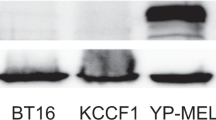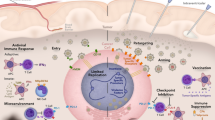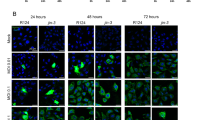Abstract
Hemagglutinating virus of Japan envelope (HVJ-E) vector with inactivated replication-defective Sendai virus was originally developed as a versatile drug delivery system. Recently, we have shown the direct tumor-killing activity of HVJ-E itself without therapeutic molecules in prostate cancer cells. Although human glioblastoma cells were also sensitive to HVJ-E treatment, complete eradication was not achieved using HVJ-E alone. Here, to develop more effective therapeutic strategy of glioblastoma, we enhanced the anti-tumor activity by incorporating Short interfering RNA (siRNA) of mitotic motor protein Eg5 into HVJ-E. Treatment with HVJ-E-containing Eg5 siRNA induced monopolar spindle formation and resulted in cell-cycle arrest and apoptosis. When HVJ-E-containing Eg5 siRNA was directly injected into an intradermal tumor xenograft, all mice became tumor-free. Similar results were observed in the intracranial tumor xenografts. The survival time of treated mice was significantly prolonged when HVJ-E was used. Histological examination showed that tumors remained in the brain after treatment with HVJ-E-containing negative control siRNA, but no tumors were detected after treatment with HVJ-E-containing Eg5 siRNA. This remarkable anti-tumor response was likely due to a synergistic effect of Eg5 siRNA and HVJ-E. Thus, this combination shows promise as an attractive novel therapy for glioblastoma.
This is a preview of subscription content, access via your institution
Access options
Subscribe to this journal
Receive 12 print issues and online access
$259.00 per year
only $21.58 per issue
Buy this article
- Purchase on Springer Link
- Instant access to full article PDF
Prices may be subject to local taxes which are calculated during checkout








Similar content being viewed by others
References
Stupp R, Mason WP, van den Bent MJ, Weller M, Fisher B, Taphoorn MJ et al. Radiotherapy plus concomitant and adjuvant temozolomide for glioblastoma. N Engl J Med 2005; 352: 987–996.
Barnholtz-Sloan JS, Sloan AE, Schwartz AG . Relative survival rates and patterns of diagnosis analyzed by time period for individuals with primary malignant brain tumor, 1973–1997. J Neurosurg 2003; 99: 458–466.
Tait MJ, Petrik V, Loosemore A, Bell BA, Papadopoulos MC . Survival of patients with glioblastoma multiforme has not improved between 1993 and 2004: analysis of 625 cases. Br J Neurosurg 2007; 21: 496–500.
Hou LC, Veeravagu A, Hsu AR, Tse VC . Recurrent glioblastoma multiforme: a review of natural history and management options. Neurosurg Focus 2006; 20: E3.
Wood KW, Cornwell WD, Jackson JR . Past and future of the mitotic spindle as an oncology target. Curr Opin Pharmacol 2001; 1: 370–377.
Sawin KE, Mitchison TJ . Mutations in the kinesin-like protein Eg5 disrupting localization to the mitotic spindle. Proc Natl Acad Sci USA 1995; 92: 4289–4293.
Sharp DJ, McDonald KL, Brown HM, Matthies HJ, Walczak C, Vale RD et al. The bipolar kinesin, KLP61F, cross-links microtubules within interpolar microtubule bundles of Drosophila embryonic mitotic spindles. J Cell Biol 1999; 144: 125–138.
Blangy A, Lane HA, d'Hérin P, Harper M, Kress M, Nigg EA . Phosphorylation by p34cdc2 regulates spindle association of human Eg5, a kinesin-related motor essential for bipolar spindle formation in vivo. Cell 1995; 83: 1159–1169.
Jaffrézou JP, Dumontet C, Derry WB, Durán G, Chen G, Tsuchiya E et al. Novel mechanism of resistance to paclitaxel (Taxol) in human K562 leukemia cells by combined selection with PSC 833. Oncol Res 1995; 7: 517–527.
Quasthoff S, Hartung HP . Chemotherapy-induced peripheral neuropathy. J Neurol 2002; 249: 9–17.
Mayer TU, Kapoor TM, Haggarty SJ, King RW, Schreiber SL, Mitchison TJ . Small molecule inhibitor of mitotic spindle bipolarity identified in a phenotype-based screen. Science 1999; 286: 971–974.
Cox CD, Breslin MJ, Mariano BJ, Coleman PJ, Buser CA, Walsh ES et al. Kinesin spindle protein (KSP) inhibitors. Part 1: the discovery of 3,5-diaryl-4,5-dihydropyrazoles as potent and selective inhibitors of the mitotic kinesin KSP. Bioorg Med Chem Lett 2005; 15: 2041–2045.
Nakazawa J, Yajima J, Usui T, Ueki M, Takatsuki A, Imoto M et al. A novel action of terpendole E on the motor activity of mitotic Kinesin Eg5. Chem Biol 2003; 10: 131–137.
Brier S, Lemaire D, Debonis S, Forest E, Kozielski F . Identification of the protein binding region of S-trityl-L-cysteine, a new potent inhibitor of the mitotic kinesin Eg5. Biochemistry 2004; 43: 13072–13082.
Sakowicz R, Finer JT, Beraud C, Crompton A, Lewis E, Fritsch A et al. Antitumor activity of a kinesin inhibitor. Cancer Res 2004; 64: 3276–3280.
Gartner M, Sunder-Plassmann N, Seiler J, Utz M, Vernos I, Surrey T et al. Development and biological evaluation of potent and specific inhibitors of mitotic Kinesin Eg5. Chembiochem 2005; 6: 1173–1177.
Sarli V, Huemmer S, Sunder-Plassmann N, Mayer TU, Giannis A . Synthesis and biological evaluation of novel EG5 inhibitors. Chembiochem 2005; 6: 2005–2013.
Müller C, Gross D, Sarli V, Gartner M, Giannis A, Bernhardt G et al. Inhibitors of kinesin Eg5: antiproliferative activity of monastrol analogues against human glioblastoma cells. Cancer Chemother Pharmacol 2007; 59: 157–164.
Koller E, Propp S, Zhang H, Zhao C, Xiao X, Chang M et al. Use of a chemically modified antisense oligonucleotide library to identify and validate Eg5 (kinesin-like 1) as a target for antineoplastic drug development. Cancer Res 2006; 66: 2059–2066.
Sioud M . Ribozyme- and siRNA-mediated mRNA degradation: a general introduction. Methods Mol Biol 2004; 252: 1–8.
Dorsett Y, Tuschl T . siRNAs: applications in functional genomics and potential as therapeutics. Nat Rev Drug Discov 2004; 3: 318–329.
Miyagishi M, Hayashi M, Taira K . Comparison of the suppressive effects of antisense oligonucleotides and siRNAs directed against the same targets in mammalian cells. Antisense Nucleic Acid Drug Dev 2003; 13: 1–7.
Yokota T, Miyagishi M, Hino T, Matsumura R, Tasinato A, Urushitani M et al. siRNA-based inhibition specific for mutant SOD1 with single nucleotide alternation in familial ALS, compared with ribozyme and DNA enzyme. Biochem Biophys Res Commun 2004; 314: 283–291.
Urban-Klein B, Werth S, Abuharbeid S, Czubayko F, Aigner A . RNAi-mediated gene-targeting through systemic application of polyethylenimine (PEI)-complexed siRNA in vivo. Gene Ther 2005; 12: 461–466.
Kaneda Y, Nakajima T, Nishikawa T, Yamamoto S, Ikegami H, Suzuki N et al. Hemagglutinating virus of Japan (HVJ) envelope vector as a versatile gene delivery system. Mol Ther 2002; 6: 219–226.
Kaneda Y . New vector innovation for drug delivery: development of fusigenic non-viral particles. Curr Drug Targets 2003; 4: 599–602.
Kaneda Y, Yamamoto S, Nakajima T . Development of HVJ envelope vector and its application to gene therapy. Adv Genet 2005; 53: 307–332.
Ito M, Yamamoto S, Nimura K, Hiraoka K, Tamai K, Kaneda Y . Rad51 siRNA delivered by HVJ envelope vector enhances the anti-cancer effect of cisplatin. J Gene Med 2005; 7: 1044–1052.
Mima H, Yamamoto S, Ito M, Tomoshige R, Tabata Y, Tamai K et al. Targeted chemotherapy against intraperitoneally disseminated colon carcinoma using a cationized gelatin-conjugated HVJ envelope vector. Mol Cancer Ther 2006; 5: 1021–1028.
Kurooka M, Kaneda Y . Inactivated Sendai virus particles eradicate tumors by inducing immune responses through blocking regulatory T cells. Cancer Res 2007; 67: 227–236.
Fujihara A, Kurooka M, Miki T, Kaneda Y . Intratumoral injection of inactivated Sendai virus particles elicits strong antitumor activity by enhancing local CXCL10 expression and systemic NK cell activation. Cancer Immunol Immunother 2008; 57: 73–84.
Kawaguchi Y, Miyamoto Y, Inoue T, Kaneda Y . Efficient eradication of hormone-resistant human prostate cancers by inactivated Sendai virus particle. Int J Cancer 2009; 124: 2478–2487.
Brufman G, Halpern J, Sulkes A, Catane R, Biran S . Procarbazine, CCNU and vincristine (PCV) combination chemotherapy for brain tumors. Oncology 1984; 41: 239–241.
Tao W, South VJ, Diehl RE, Davide JP, Sepp-Lorenzino L, Fraley ME et al. An inhibitor of the kinesin spindle protein activates the intrinsic apoptotic pathway independently of p53 and de novo protein synthesis. Mol Cell Biol 2007; 27: 689–698.
Marcus AI, Peters U, Thomas SL, Garrett S, Zelnak A, Kapoor TM et al. Mitotic kinesin inhibitors induce mitotic arrest and cell death in Taxol-resistant and -sensitive cancer cells. J Biol Chem 2005; 280: 11569–11577.
DeBonis S, Skoufias DA, Lebeau L, Lopez R, Robin G, Margolis RL et al. In vitro screening for inhibitors of the human mitotic kinesin Eg5 with antimitotic and antitumor activities. Mol Cancer Ther 2004; 3: 1079–1090.
Shi J, Orth JD, Mitchison T . Cell type variation in responses to antimitotic drugs that target microtubules and kinesin-5. Cancer Res 2008; 68: 3269–3276.
Kawachi M, Tamai K, Saga K, Yamazaki T, Fujita H, Shimbo T et al. Development of tissue-targeting hemagglutinating virus of Japan envelope vector for successful delivery of therapeutic gene to mouse skin. Hum Gene Ther 2007; 18: 881–894.
Saga K, Tamai K, Kawachi M, Shimbo T, Fujita H, Yamazaki T et al. Functional modification of Sendai virus by siRNA. J Biotechnol 2008; 133: 386–394.
Shimbo T, Kawachi M, Saga K, Fujita H, Yamazaki T, Tamai K et al. Development of a transferrin receptor-targeting HVJ-E vector. Biochem Biophys Res Commun 2007; 364: 423–428.
Debinski W, Gibo DM . Molecular expression analysis of restrictive receptor for interleukin 13, a brain tumor-associated cancer/testis antigen. Mol Med 2000; 6: 440–449.
Kuan CT, Wikstrand CJ, Bigner DD . EGFRvIII as a promising target for antibody-based brain tumor therapy. Brain Tumor Pathol 2000; 17: 71–78.
Kaneda Y . Applications of hemagglutinating virus of Japan in therapeutic delivery systems. Expert Opin Drug Deliv 2008; 5: 221–233.
Formstecher E, Reverdy C, Cholay M, Planquette C, Trouplin V, Lehrmann H et al. Combination of active and inactive siRNA targeting the mitotic kinesin Eg5 impairs silencing efficiency in several cancer cell lines. Oligonucleotides 2006; 16: 387–394.
Zagzag D, Amirnovin R, Greco MA, Yee H, Holash J, Wiegand SJ et al. Vascular apoptosis and involution in gliomas precede neovascularization: a novel concept for glioma growth and angiogenesis. Lab Invest 2000; 80: 837–849.
Acknowledgements
This work was supported by the Northern Osaka (Saito) Biomedical Knowledge-Based Cluster Creation Project, and Special Coordination Funds for Promoting Science by the Ministry of Education, Culture, Sports, Science and Technology of Japan.
Author information
Authors and Affiliations
Corresponding author
Rights and permissions
About this article
Cite this article
Matsuda, M., Yamamoto, T., Matsumura, A. et al. Highly efficient eradication of intracranial glioblastoma using Eg5 siRNA combined with HVJ envelope. Gene Ther 16, 1465–1476 (2009). https://doi.org/10.1038/gt.2009.99
Received:
Revised:
Accepted:
Published:
Issue Date:
DOI: https://doi.org/10.1038/gt.2009.99
Keywords
This article is cited by
-
The combination of chemotherapy with HVJ-E containing Rad51 siRNA elicited diverse anti-tumor effects and synergistically suppressed melanoma
Gene Therapy (2012)
-
Immunogene therapy using immunomodulating HVJ-E vector augments anti-tumor effects in murine malignant glioma
Journal of Neuro-Oncology (2011)



